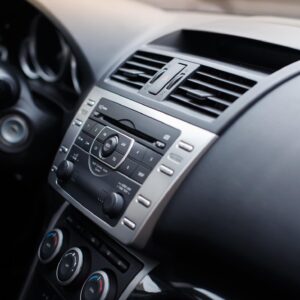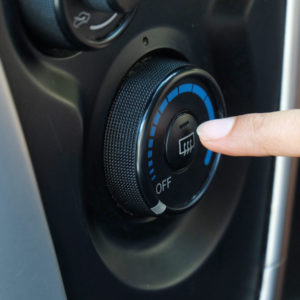When people think of their car heater, they often only think about how useful it is during the cold winter days. However, you’d be surprised by just how useful car heaters are throughout the year.
As a part of your vehicle’s cooling system, your vehicle’s heater actually does so much more than just keep you and your passengers warm in the cabin, if only you knew how to make the most of it.
How Does a Car Heater Work
Your vehicle’s cooling system’s primary function is to keep your engine from overheating, but how exactly does it do that? Well, this is where your car heater comes in. Your car heater is made up of key components, namely the following:
- Heater Core (it’s like a small radiator)
- Heater Hoses
- Heater Control Valve
- Engine thermostat
- Blower Motor
- Heating, Ventilation, and Air Conditioning (HVAC) Control Panel
Your engine generates heat as soon as it starts running. While most of that heat goes out through the exhaust system, some of it gets picked up by the coolant in your car’s HVAC system.
When the engine is first started, the cooling system thermostat is closed on modern engines so that the coolant is typically sent directly through the heater core rather than through the radiator to provide cabin heat as soon as possible. On these platforms, the heater control valve will bypass the heater core when closed (like on hot days when the A/C is used).
The heater fan blows air through the heater core, pushing warm air into the cabin. The heater core, like the radiator, is basically a heat exchanger that transfers heat from the coolant passing through it into the fins around the heater core tubes and into the air passing through the fins.


How To Make the Most Out of Your Car Heater
The car heating system is one of the most important systems in any vehicle, but not a lot of owners actually know how to make the most out of it.
Move the Car
It might seem tempting to sit in your car and wait for your heater to start blasting before driving off, but you’ll actually feel warmer faster if you don’t wait around.
Most modern cars typically don’t need to warm up before being driven, but it can take a while to warm up the cabin if you don’t immediately start driving.
Don’t Turn the Heat up Too High
Cars with automatic climate control should be easy enough to use. All you have to do is set the system to the temperature you like and your car should warm up in just a few minutes.
However, cranking the temperature and fan too high just to speed up the process doesn’t really work. Your car will warm up just as fast as if you cranked the dial to maximum. The only difference is you end up force-feeding a lot of warm air to your passengers.
Let Your A/C Dehumidify the Air
When people think of their air conditioning (A/C) systems, they often only think of cold air. While your A/C is certainly responsible for keeping your cabin cool, it isn’t the only thing it’s capable of.
Your A/C also acts as a dehumidifier by removing moisture from the air to keep your windows from fogging up. Notice in the previous diagram that the air passes through the A/C evaporator before ever going to the heater core. This is by design so the evaporator can dehumidify the air. Typically, the A/C will automatically engage when you select “Defrost” for that reason.
Don’t Use the Recirculation Mode
As tempting as it might be to keep all that warm air inside, it actually isn’t a good idea to turn on your A/C system’s recirculation mode. Your breath releases water vapor back into the cabin, and with enough passengers in the cabin, this can cause your windows to fog. This, however, usually won’t happen unless there are many people in the car.
Use the Defrost Mode
Are your windows fogging up? You can always use your A/C system’s defrost mode to fix that. This feature automatically engages your A/C at a high fan speed, directing warm, dry air to get rid of the fog on your windshields and front side windows.
Make Sure the Heat Reaches the Backseat
You might be making the most of your heater in the driver’s seat, but how much of that warm air is actually reaching your passengers in the backseat? Consider cranking up the fan so it’s strong enough to reach them, even if it means you’ll have to turn the temperature down a little to relieve the ones in the front seats.
Just Use the Heater
In the summer, some people tend to skip on the A/C to save on fuel and money. However, you don’t have to worry about that when you want to use your heater during cold winter days.
Your engine generates heat as soon as it starts running, which means you’re free to use your heater without using up too much fuel. In fact, leaving your heater turned off would be kind of a waste since all that unused heat ends up dumped through the radiator.
Does a Car Heater Use Gas?
The simple answer is yes. Car heaters do use gas, but they don’t do so directly. Your engine naturally generates heat whenever it’s running, and this heat is sent to the coolant, where the car heater draws heat from to blow warm air into the cabin.
Note, however, that the car doesn’t burn any more gas while using the heater except for a slight load on the alternator while the blower is running. But this is such a small amount as to be inconsequential.
So just because your car heater doesn’t use gas to produce heat doesn’t mean it doesn’t need gas. Car heaters need some electricity to power the system’s internal fan, but it really only needs a small amount of fuel.
Where to Get a New Heater for Your Vehicle
Driving in the cold is one of the most unbearable things you’re bound to experience when you’ve got a damaged heater on your hands. It can get even more annoying when you’re stuck in traffic, too.
Make sure to replace your vehicle’s damaged heater as soon as possible. For an OE-grade replacement that won’t break the bank, shop here at CarParts.com. We have a great selection of A/C and heater parts that come as direct-fit replacements for your vehicle.
Made from only the finest materials available, our A/C and heater parts passed the highest quality control standards from industry professionals.
Enter your vehicle’s year, make, and model into our vehicle selector to find top-notch components for your ride in a matter of minutes. Check out securely with a few clicks, and get your order delivered straight to your doorstep in as fast as two business days.
Can’t shop online? We’ve got you covered. Call us using our toll-free hotline anytime, and our round-the-clock customer service representatives will be ready to assist you.
Don’t miss out on the best deals on the market, and shop for what you need today!
Any information provided on this Website is for informational purposes only and is not intended to replace consultation with a professional mechanic. The accuracy and timeliness of the information may change from the time of publication.







































